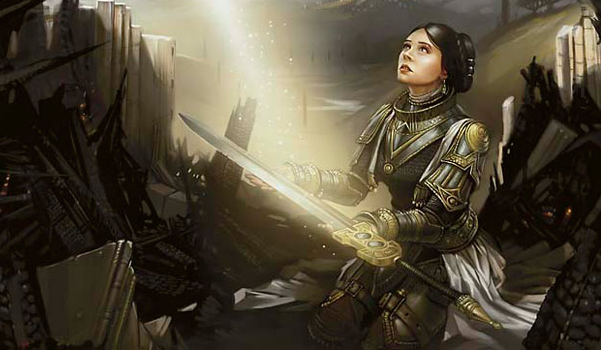Are you a Quiet Speculation member?
If not, now is a perfect time to join up! Our powerful tools, breaking-news analysis, and exclusive Discord channel will make sure you stay up to date and ahead of the curve.
And now, to wrap things up. I've talked about the setup and the hard data, but that doesn't tell the whole story. It's usually the intangible or at least unquantifiable observations that most inform decisions. I made a number of observations and ancillary impacts during my testing that changed how I see Hypergenesis. Today, I'll be sharing those insights and my conclusions. The data is fairly clear about what to expect from Hypergenesis, but it didn't capture the really troubling aspect.

On Power
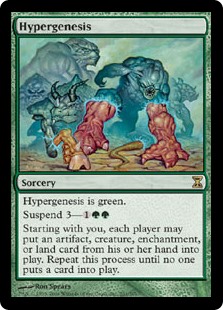 So the most obvious question is the power. Is Hypergenesis too strong for Modern? On the one hand, the data clearly showed that Hypergenesis wins more than Neoform. Which isn't saying much; Neoform's been around for years with no real metagame impact, so a better version sounds harmless. Such a conclusion is reinforced by Hypergenesis lacking a truly favorable matchup in my sample. It has a very powerful and fast combo, but gets disrupted left and right. And even against the noninteractive decks, the matchup was even at best.
So the most obvious question is the power. Is Hypergenesis too strong for Modern? On the one hand, the data clearly showed that Hypergenesis wins more than Neoform. Which isn't saying much; Neoform's been around for years with no real metagame impact, so a better version sounds harmless. Such a conclusion is reinforced by Hypergenesis lacking a truly favorable matchup in my sample. It has a very powerful and fast combo, but gets disrupted left and right. And even against the noninteractive decks, the matchup was even at best.
However, I feel the data is misleading. Not that the data is wrong or untrue, but the experience I gained during the test tells me I misbuilt the deck enough to affect the results. I got a pretty good number of turn 1 kills, but it should have been higher. I frequently had 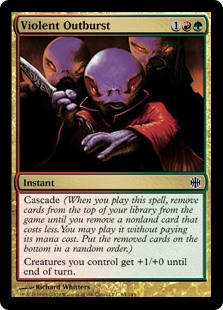 hands where I had everything for an actual turn 1 win except Violent Outburst. Demonic Dread requires a creature to target, which will only happen turn 1 on the play with Forbidden Orchard. The odds aren't great, but it's not the worst problem. The worst is that Ardent Plea cannot kill turn 1 on the play, as there's no way to make 1WU in the deck before turn 2 because cascade prevents it from running Manamorphose or Wild Cantor.
hands where I had everything for an actual turn 1 win except Violent Outburst. Demonic Dread requires a creature to target, which will only happen turn 1 on the play with Forbidden Orchard. The odds aren't great, but it's not the worst problem. The worst is that Ardent Plea cannot kill turn 1 on the play, as there's no way to make 1WU in the deck before turn 2 because cascade prevents it from running Manamorphose or Wild Cantor.
Subsequently, I had to rage at many hands that would have killed with Outburst, and a few with Dread but couldn't thanks to Plea. I've done some testing with the same deck since, and replacing Plea with Bloodbraid Elf appears the right call. Which tells me that I hamstrung Hypergenesis. Consequently, I think the actual win percentage in the test was lower than what it would be if unbanned. There's more power in the shell than I harnessed.
An Important Lesson
And then there's the issue of Tibalt's Trickery. That deck played similarly to Hypergenesis, but 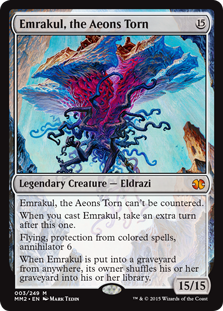 only dropped one creature. Subsequently, it was more explosive, but not necessarily more powerful. It wasn't really doing anything in Modern, but it is not and may never be clear if it could have. Tibalt, Cosmic Imposter was so dominant that it may have covered up Trickery's real power. Wizards feared that, anyway, which is why Trickery was banned. However, that debacle does suggest that a similar deck would be too good.
only dropped one creature. Subsequently, it was more explosive, but not necessarily more powerful. It wasn't really doing anything in Modern, but it is not and may never be clear if it could have. Tibalt, Cosmic Imposter was so dominant that it may have covered up Trickery's real power. Wizards feared that, anyway, which is why Trickery was banned. However, that debacle does suggest that a similar deck would be too good.
Admittedly, there are more ways to stop Hypergenesis than Trickery. Chalice of the Void for 0 and Containment Priest spring to mind, but a resolved Hypergenesis also lets Ensnaring Bridge hit play and stop the shenanigans. I'm not sure that makes up for the gameplay problems, but it also isn't nothing. I think that Wizards has made its position very clear, but that doesn't mean either Trickery or Hypergenesis are too strong in a vacuum.
The Unexpected Key
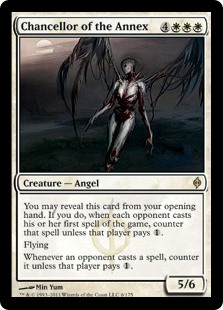 That said, Hypergenesis's win rate would unequivocally have been lower if I wasn't running Chancellor of the Annex. From Legacy experience I knew the card would be very good. There's nothing better at defending against a Force of Negation turn 1 than a revealed Chancellor. However, that was only relevant against 4-Color Omnath, and only occasionally. It also protects against turn 1 discard, but that similarly was a niche use in the test. The real benefit is the general disruption. A revealed Annex Mana Tithes everyone's first play, which puts every deck off their curve. While there are work-arounds, including just throwing away a spell, it was a huge benefit and bought significant time against every deck.
That said, Hypergenesis's win rate would unequivocally have been lower if I wasn't running Chancellor of the Annex. From Legacy experience I knew the card would be very good. There's nothing better at defending against a Force of Negation turn 1 than a revealed Chancellor. However, that was only relevant against 4-Color Omnath, and only occasionally. It also protects against turn 1 discard, but that similarly was a niche use in the test. The real benefit is the general disruption. A revealed Annex Mana Tithes everyone's first play, which puts every deck off their curve. While there are work-arounds, including just throwing away a spell, it was a huge benefit and bought significant time against every deck.
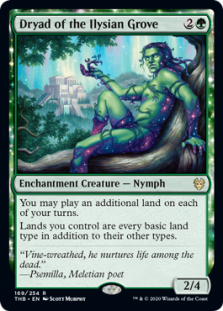 What I didn't expect was how devastating Annex was against Amulet Titan specifically. The test list was just over half land, which meant that a typical hand had less than three spells. Additionally, over half the lands in Amulet come into play tapped. As a result, Annex was often unchallenged until turn 3, which meant that Amulet couldn't deploy a Dryad of the Ilysian Grove or Azuza, Lost but Seeking on curve, which then bought Hypergenesis at least one more turn, and usually two, before Valakut came online. This threw Amulet's game off enough that we discussed at length the value of throwing an otherwise essential Summoner's Pact away just so Amulet could actually play. We even considered boarding in another Engineered Explosives just to throw it at the Tithe.
What I didn't expect was how devastating Annex was against Amulet Titan specifically. The test list was just over half land, which meant that a typical hand had less than three spells. Additionally, over half the lands in Amulet come into play tapped. As a result, Annex was often unchallenged until turn 3, which meant that Amulet couldn't deploy a Dryad of the Ilysian Grove or Azuza, Lost but Seeking on curve, which then bought Hypergenesis at least one more turn, and usually two, before Valakut came online. This threw Amulet's game off enough that we discussed at length the value of throwing an otherwise essential Summoner's Pact away just so Amulet could actually play. We even considered boarding in another Engineered Explosives just to throw it at the Tithe.
An interesting note is that Scourge Shadow was the second-most impacted deck, but in an unexpected way. It had the best way to dodge thanks to Mishra's Bauble, but that didn't always line up nicely. Squandering the cantrip hurt. However, the real problem was that Scourge is so mana-tight that it usually had no choice but to throw away a meaningful card. If it didn't, it would be perpetually locked out of the game. And that hurt even more.
Time on My Side
While it doesn't really factor in terms of power, I would like to state for the record that this test was by far the easiest one I've done. Most of this was the deck. As mentioned, it was wrong to try to be fancy with Hypergenesis. I just mulliganed for land, cascade spell, and payoff, then jammed it at the first opportunity. I didn't have to think or stress, which was a huge relief considering how tricky Neoform is, both in terms of piloting and the actual combo. 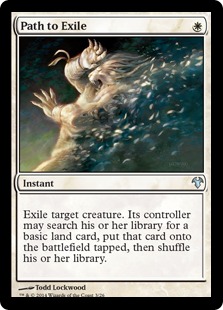 Jamming Violent Outburst was a welcome relief compared to trying to assemble all the bits and pieces of Neoform's combo, and attacking with fatties is much easier than keeping track of all the cards you've drawn and trying to assemble them in exactly the right order to win.
Jamming Violent Outburst was a welcome relief compared to trying to assemble all the bits and pieces of Neoform's combo, and attacking with fatties is much easier than keeping track of all the cards you've drawn and trying to assemble them in exactly the right order to win.
Consequently, this test went faster than the others. I started actually recording data in mid-November and was done by early January. The others took four months at minimum. The entire DnT test took two days. While ease of play was a major factor, the nature of the decks also meant that matches were quickly resolved. Either the glass-cannons went off or they were disrupted into defeat. No back-and-forth; no scraping out a win. The only exceptions were a few games against 4-C Omnath and DnT. In those cases, Hypergenesis went off without dropping Emrakul, the Aeons Torn or Keeper of Progenitus; without the untargetable creatures, Path to Exile was devastating, and bought both decks the time and space they needed to contain whatever was left. However, the vast majority of games only lasted four turns.
A Curious Observation
All that said, I must admit that the most revelatory observation wasn't actually mine. About 60% of the way through testing, the Amulet Titan player observed that Hypergenesis seemed to be winning more on the draw than the play. I hadn't thought about it at all up to that point, but I had noticed that games felt better on the draw than play. Not something quantifiable or even identifiable, I just felt more comfortable on the draw. I checked with the 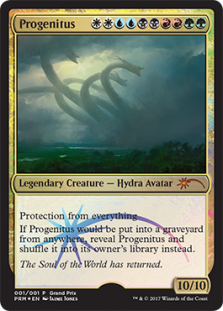 other players, and they confirmed feeling similarly. DnT said they found being on the draw terrifying, and not just because Demonic Dread was more likely to be live. They'd already boarded out Giver of Runes just to make Dread less useful.
other players, and they confirmed feeling similarly. DnT said they found being on the draw terrifying, and not just because Demonic Dread was more likely to be live. They'd already boarded out Giver of Runes just to make Dread less useful.
With that consensus opinion, I did keep track of subsequent games, and I did win more on the draw than play. Not by a lot, and maybe not enough to statistically evaluate (small overall n of observations). But the bump was definitely present. And felt more decisive than wins on the play. It was late enough in the process that the data doesn't really mean anything, but what data I have and the impressions from the other players does lead me to think that it plausible that Hypergenesis should choose to draw. This is not only completely counterintuitive but also contrary to Neoform's games.
Uncertain Causation
I don't know why drawing appeared to be better for Hypergenesis. I've goldfished a number of times and jammed some test games looking for a reason. It goes against expectations because it's giving up a tempo advantage and giving opponents the opportunity to interact turn 1. However, the impression holds, and I think it's more drastic than expected. The effect is too hard to pin down without significant testing, so I'm not certain that it's statistically provable, but I can't dismiss it either. Current theories include:
A) More Cascade Options
As I've mentioned above, Ardent Plea and Demonic Dread were the weak links in the deck. Plea's mana was wrong for the deck, Dread needs a target and I didn't often open Dread and Forbidden Orchard. Being on the draw helped both problems, the latter most of all. I got more chances to topdeck the Orchard for Dread, plus it gave my opponent the opportunity to play a creature. The latter was helped with mana smoothing and the rare chance when I had the singleton Gemstone Caverns to actually go off turn 1.
B) The Extra Card Is Critical
As much as I praised Annex, the main point of this deck is dropping Emrakul or Progenitus early. There's a reason that having a cascade card, either legend, and mana was a keep regardless of matchup. With no card draw or library manipulation, the extra topdeck is the only way to improve the chances of finding the critical creatures. Barring that, simply having an extra fatty to overwhelm the opponent is pretty good.
C) A Way Around Disruption
Finally, there is something to be said for drawing a card against disruption spells. There's a lot of redundancy in playing 12 cascade spells, and drawing a replacement is huge, particularly against discard.
What About the Ban?
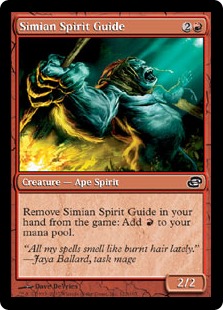 The final thing to discuss is the loss of Simian Spirit Guide. It's a key component because it's half the deck's fast mana. The loss necessarily slows Hypergenesis down, which would make it a far less threatening combo.
The final thing to discuss is the loss of Simian Spirit Guide. It's a key component because it's half the deck's fast mana. The loss necessarily slows Hypergenesis down, which would make it a far less threatening combo.
Except, what if SSG was just a crutch? What if Hypergenesis isn't actually slowed down? It might have sped up thanks to the ban. Counterintuitive, but it makes sense to me given what I've learned in this test. With a few adjustments, I think that Hypergenesis would be just fine, or maybe better than before.
First, the deck wasn't able to kill as often as it theoretically could because Ardent Plea doesn't mesh with Guide and Chancellor of the Tangle. It was an unsolvable mana conflict. Secondly, the Trickery decks were more explosive but less overwhelming versions of Hypergenesis. However, their cousin, Tibalt Cascade, was the better deck. Thirdly, it appears that Hypergenesis wants to be on the draw.
Putting it Together
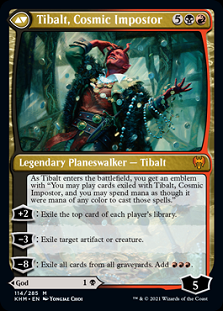 The lesson from Tibalt Cascade is what really got me thinking. Toward the end of their reign, the number of Gemstone Caverns were ticking up. The decks needed to go off turn 1 as often as possible, and suddenly it got easier to pull off on the draw. Hypergenesis wants to draw. That should mean that, theoretically, I can replace SSG with a full set of Caverns, plan to draw, and have at least as good odds of going off turn 1 with Cavern, another land, and Tangle. Or maybe better odds because Caverns would be a rainbow land, making it possible to combo off with Ardent Plea turn 1. Exiling a Chancellor you've already revealed mitigates Cavern's card disadvantage, as does the extra topdeck from drawing. There's more risk since Cavern is legendary and useless unless in the opening hand, but maybe the upside is worth it.
The lesson from Tibalt Cascade is what really got me thinking. Toward the end of their reign, the number of Gemstone Caverns were ticking up. The decks needed to go off turn 1 as often as possible, and suddenly it got easier to pull off on the draw. Hypergenesis wants to draw. That should mean that, theoretically, I can replace SSG with a full set of Caverns, plan to draw, and have at least as good odds of going off turn 1 with Cavern, another land, and Tangle. Or maybe better odds because Caverns would be a rainbow land, making it possible to combo off with Ardent Plea turn 1. Exiling a Chancellor you've already revealed mitigates Cavern's card disadvantage, as does the extra topdeck from drawing. There's more risk since Cavern is legendary and useless unless in the opening hand, but maybe the upside is worth it.
My Assessment
I have no problem with Hypergenesis as a fast combo. Modern needs fast and unfair combos to keep slow multicolored sludge decks in check. Unfair combo prevents decks from infinitely durdling and requires decks play interaction, if not maindeck then sideboard, to not just lose to a nontraditional attack. Hypergenesis is better Neoform, and I think Modern can handle better Neoform. Given history, better Neoform is not a high bar.
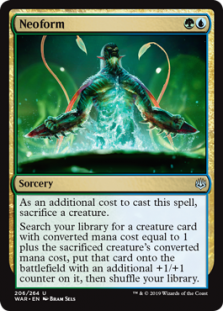 However, that is true if and only if unfair combo can't win on turn 1 too often. Winning then occasionally is fine, but even Legacy doesn't like consistent turn 1 combos. My data showed that Hypergenesis would win turn 1 more often than Neoform could. I have reason to believe that Hypergenesis' real turn 1 rate should have been higher. And may have increased since the test. My testing also showed that sideboard cards were usually too slow to make or break the matchup. Thus, I believe that unbanning Hypergenesis brings a huge risk to Modern's health. I would recommend keeping it banned out of concern of early wins rather than power level.
However, that is true if and only if unfair combo can't win on turn 1 too often. Winning then occasionally is fine, but even Legacy doesn't like consistent turn 1 combos. My data showed that Hypergenesis would win turn 1 more often than Neoform could. I have reason to believe that Hypergenesis' real turn 1 rate should have been higher. And may have increased since the test. My testing also showed that sideboard cards were usually too slow to make or break the matchup. Thus, I believe that unbanning Hypergenesis brings a huge risk to Modern's health. I would recommend keeping it banned out of concern of early wins rather than power level.
Risk Management
Unbans are all about risk vs. reward. Given what I found, I think that the risk posed by Hypergenesis's theoretical speed outweighs the benefit of getting a better Neoform deck. Unless Wizards decides to completely kill off all fast mana in Modern, Hypergenesis is too dangerous to be released.


